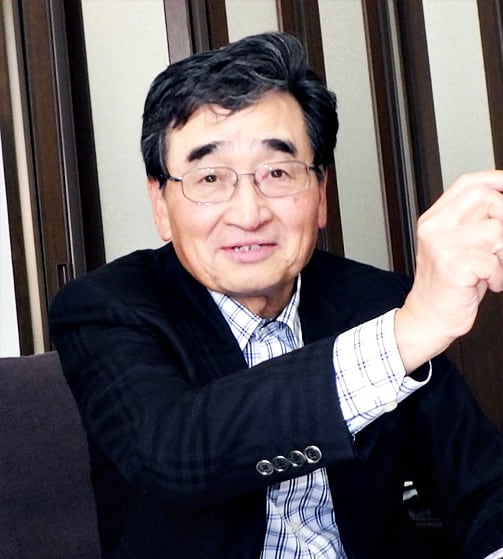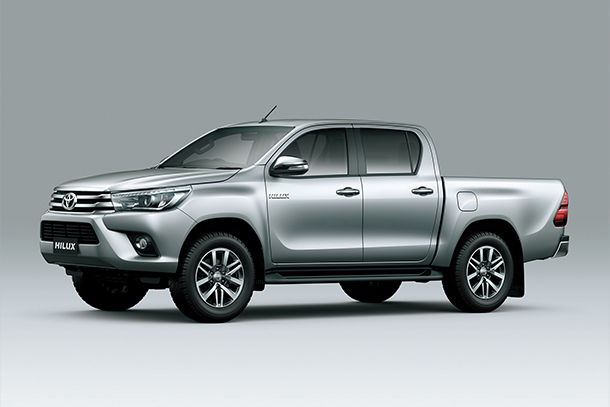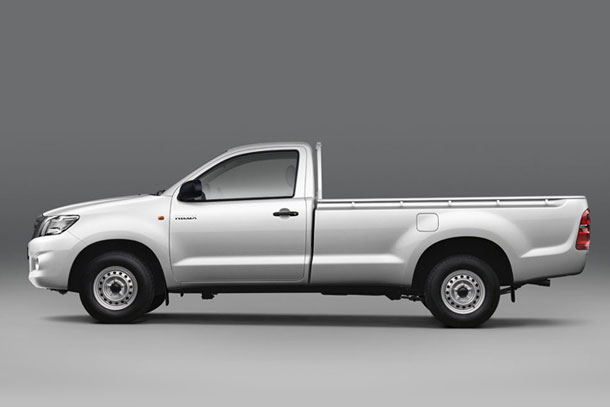Jul. 26, 2018
Masaaki Ishiko, Chief Engineer for the 6th generation Hilux
The Thrill of Realizing I had been Involved in Developing the Hilux for More than 18 Years
After joining Toyota Motor Corporation in 1967, I was involved in the design of vehicle suspension for many years and in 1980 was put in charge of the Hilux in the Product Planning Division. At that time, the development policy for the fourth generation had just been decided upon, following the debut of the third-generation Hilux. That Hilux model, which featured four-wheel drive for the first time and a remarkably tall vehicle height, left a major impact on the market.
The development theme for the fourth generation was "Looks like a pickup truck, but rides like a passenger car." Therefore, our goal was to develop a vehicle that would not only provide a full range of pick-up truck functions, but could also be used as a passenger car offering excellent riding comfort and driving performance. In developing the fifth-generation Hilux as a vehicle that can also be used as a passenger car, we changed the conventional image of a pickup truck as a work vehicle.
Then, we set the development theme for the fifth generation as "targeted at men/sophisticated" and established a goal to evolve the Hilux into a powerful yet sophisticated vehicle.
The design was carried out on a part-by-part basis and the evaluation was also subcontracted to our affiliated companies according to individual performance parameters. Furthermore, production was done both internally and at affiliated companies, which complicated the incorporation of production technologies. Therefore, in order to unify the mindset of all involved, it was necessary to set up a design theme.
In terms of body variations, a new Extra Cab version was added to the Single Cab and Double Cab versions. This new version improved the habitability and extending the cabin further also made it possible to install jump seats in the back.
After a four-door version was added to the Hilux Surf, the two-door version was eventually discontinued.
Simultaneously Achieving Different Objectives was the Mission of the Hilux Development Team
Although this is evident from the development theme, attaining high-speed driving performance and four-wheel driving performance, for example, involved conflicting requirements. While a low center of gravity, a long wheelbase, and a light unsprung weight are ideal for high-speed driving, a tall vehicle height, large tires, and a short wheelbase are necessary for four-wheel driving on uneven surfaces.
Take the loading capacity, for example. The base Hilux was a 1-ton vehicle. However, in North America, that model was used mostly by young people for enjoying life. Therefore, it was necessary to place more importance on riding comfort by reducing the loading capacity to 0.5 tons.
In contrast, in Southeast Asia, the Hilux was often subjected to loads greater than 1 ton. Especially, in Thailand, the model was sometimes modified into a bus carrying 40 passengers. Therefore, we had to implement some measures for the vehicle so that it could withstand such a load.
To optimally accommodate these varying requirements, we decided to offer many versions, both gasoline- and diesel-powered.
Enhancing the Variations in the Hilux Series
The Hilux Surf was originally developed primarily for North America. However, because the number of SUV fans had increased in Japan, we were able to develop an SUV independently for the Japanese market. At the time the Hilux Surf was launched, it was thought that the Surf was not needed in Japan.
The development theme for the Hilux Surf was "To beaches, to mountains, and to parties." Therefore, we aimed to create a vehicle that could be freely driven on uneven surfaces on the way to beaches and mountains, but which could also be driven to fancy hotels.
In Japan, from the start of the product launch, dealers made a wide variety of options available, which was very helpful and appreciated by us.
Starting with the middle of the fifth generation, the Hilux for the U.S. market was produced at NUMMI, a joint production venture with General Motors located near San Francisco, and the follow-on model, the Tacoma, became independent of the Hilux as a vehicle exclusively for the North American market.
The design concept was created in a suburb of Los Angeles, and we repeated discussions with parts makers while getting a great deal of help from the Toyota Technical Center located in a suburb of Detroit. Then, we managed to have the vehicle produced at NUMMI with a variety of options installed at Toyota USA.
I remember that the standing-start acceleration performance of the short pickup truck equipped with a large V6 engine favored by American drivers was referred to as "Like a rocket" at a press event.
The full-size Tundra and Sequoia also began as larger derivatives of the Hilux, but following a long early stage of development, grew into respectable full-size models. The Sequoia in particular was developed into a full-fledged, full-size model capable of accommodating 6-foot tall passengers in the third-row seats.
At the start of the planning phase for this vehicle, another idea was put forth to make the size of the Hilux between compact and full size. However, going for two sizes from the start turned out to be the right thing to do.
Facing the Sixth-Generation Hilux as Chief Engineer
The development theme for the sixth-generation Hilux was "Fun to Drive, Tough for Work." Furthermore, since overseas sites such as Thailand had grown to account for approximately half the production, we had to consolidate and select in order to reduce capital expenditure. At the same time, we also tried to do our utmost to accommodate individual requirements from the approximately 140 countries where the Hilux had been introduced. In terms of basic specifications, the height of the cab in the single-cab model was increased by 30 mm and the length of the cab in the double-cab model was extended by another 50 mm to improve habitability. The loading capacity of the extra-cab model was increased from 0.5 to 0.75 tons.
For the gasoline models, new 2.0-liter, 2.4-liter, and 2.7-liter engines were added to the existing 1.8-liter. For the diesel models, 2.4-liter, 2.4-liter Turbo, 2.8-liter, and 3.0-liter engines were added to support various types of applications.
The Vehicle Must be Reasonably Priced to be Useful as a Work Vehicle
For the Hilux to be widely used in Asia, the Middle East, and Africa, its external appearance was important, but durability and practicality were also important and the price had to be reasonable.
In terms of cost reduction in particular, we had to work extremely hard because we were confronted with significant yen appreciation. Looking back, the yen appreciated by 30 percent for each redesign that took place every five years. We all kept coming up with ideas for achieving marketability improvements, which are costly, while absorbing the impact of the currency appreciation.
Additionally, to improve driving performance and fuel efficiency, we reduced the vehicle weight by 30 kg. However, instead of achieving this through simple material replacement, we asked everyone involved to simultaneously promote both weight reduction and cost reduction with the idea that the price of cars should be the same as that of chicken, i.e., 100 yen for 100 g. So, for example, the number of grades was reduced to one to reduce the number of parts and the interior color was standardized to a single color (with the exception of vehicles for the Middle East, where one additional color was offered).
Materializing the Design through Genchi Genbutsu
Since the Hilux was being used in approximately 140 countries worldwide, our design team members travelled to these countries to observe the driving situations, and directly consulted dealers to hear their requests.
In Thailand, we accommodated a request to change the tailgate design even though it came immediately before the line-off. In addition, although the extra-cab model was a pickup truck not subject to luxury tax, for all practical purposes it was used as a passenger car. Therefore, to match this need, a stylish design was adopted, for example using unconventionally shaped headlamps.
In Australia, to match the need for high-speed driving in the suburbs, we improved the outside mirrors. Additionally, since the vehicle is often driven over muddy areas following rain, we designed the Hilux to be a vehicle that can withstand even such an environment.
In Australia, when the export origin was changed from Japan to Thailand, Australian dealers expressed some uneasiness. To ease their concern, we had the dealers visit the Thai production line to reassure them that the vehicles were being produced to Toyota quality standards.
In New Zealand, we were able to verify user needs by riding along on patrol around a farm to experience driving on slopes with a nearly 30-degree incline and fording small streams.
In the Middle East, we experienced scorching 52˚C heat and the value of oases, recognizing the importance of the engine coolant temperature gauge and taking note of the need for reliability improvements. We also drove on unpaved roads, which helped us understand the need to protect the drain plug on the rear axle. Features unique to the Middle East such as the tape stripe design, gold-colored paint on the wheel caps, and a special hood ornament, were also the results of discussions with local people. In South Africa, we were able to adjust the spring rate to accommodate high-speed driving on unpaved roads in the suburbs. Also, based on local requests, we decided to offer a 1.8-liter engine exclusively for this country.
In Argentina, as can be seen from the muddy color of Iguazu Falls, the soil particle size is small. Therefore, we paid particular attention to dust infiltration through small crevices.
In Japan, we installed a sunroof in the Hilux 4WD Double Cab and exclusive dealer options were offered from launch start to support a variety of applications.
Thrilling Experience
The sixth-generation Hilux was also widely accepted by people all over the world as a vehicle for work and life. However, starting with the seventh generation, the Hilux became a model exclusively for overseas, with the sixth generation becoming the last model for the Japanese market. Nevertheless, approximately 9,000 Hiluxes are still being driven in Japan, and their owners have told us there are no other vehicles they like enough to replace their Hiluxes. As a result, I've heard that the eighth generation will be reintroduced for the first time in 13 years into the Japanese market. Having being involved with the Hilux for more than 18 years, nothing makes me happier than this news. I look forward to sharing this joy with everyone who has been involved.
I also remember that the ideal car of the main character in the movie "Back to the Future" was a Hilux 4WD Extra Cab with all kinds of add-on equipment.
I'm looking forward to experiencing the thrill again when I come across an eighth-generation Hilux somewhere.
Thank you very much.
- CE for 6th generation Hilux
- Masaaki Ishiko
- Apr. 1967
- Joined Toyota Motor Company
- Feb. 1975
- Technical Division Tokyo Office
- Feb. 1980
- Product Planning Group (Hilux)
- Jan. 1994
- Chief Engineer, Product Planning Group
- Oct. 1998
- Resigned












